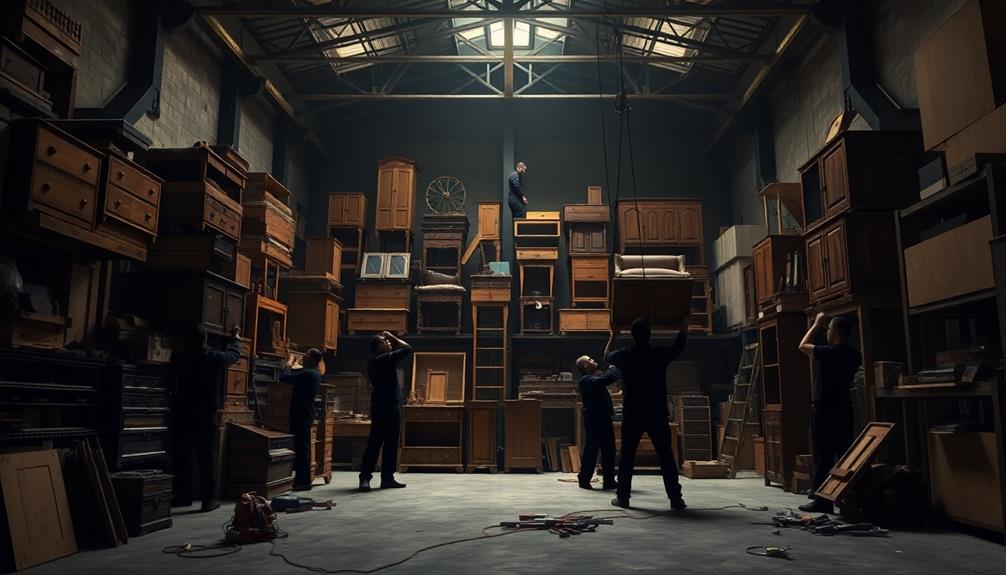In order to rearrange furniture in Lethal Company, begin by activating edit mode by pressing B to highlight the items in green. Use the R key to adjust the position of your furniture for the best fit. If obstacles block your placement, they will turn red, indicating a need for adjustment. Press X to store furniture in your ship’s storage if you are not ready to place it immediately, and finalize your placements by pressing B again. It is crucial to regularly organize your inventory to maximize your space and performance. There are many aspects of furniture management to master that can improve your gaming experience.
Key Takeaways
- Enter edit mode by pressing B to highlight the furniture in green for easy movement.
- Use the R key to rotate furniture and find optimal placement.
- Obstacles will turn furniture red, indicating the need for relocation.
- Press X to store furniture in the ship's storage if not placing immediately.
- Confirm placement by pressing B again to save changes and enhance gameplay.
Moving Furniture Basics
Moving furniture in Lethal Company can be straightforward if you follow a few simple steps. First, approach the furniture you want to move and press B to enter edit mode. This action highlights the selected item in green, indicating it's ready for adjustment. If you need to change its orientation, simply press the R key to rotate it until it's positioned just right.
For those dealing with stress during gameplay, consider using essential oils for relaxation, as they can enhance your focus and calm your nerves.
Keep an eye out for obstacles; if the furniture can't be moved to your desired spot due to obstruction, it'll turn red. This visual cue means you'll need to find another location or adjust your plan. If you decide that you don't want to place the item immediately, you can store it by pressing the X key, which sends it to the ship's storage for later use.
Once you've found the perfect spot, confirm your new placement by pressing B again to save your changes. This method guarantees your furniture is organized and functional, enhancing your gameplay experience in Lethal Company.
Accessing Storage Efficiently

To access your storage, just hit the E button and type "Storage" into the command line.
This simple command allows you to quickly view and retrieve furniture items you need. By managing your storage efficiently, you can keep your ship organized and improve overall performance.
Additionally, maintaining a clear inventory can help you avoid the financial mistake of overspending on unnecessary items, as it's important to align your resources with your budget and investment goals.
Terminal Command for Storage
Accessing storage in Lethal Company is straightforward and efficient, making it easy for you to manage your furniture. To get started, interact with the Access Terminal by pressing the E button.
Once you've done that, type "Storage" into the command line and hit Enter. This action will take you to the storage menu, where you can easily navigate through your available items. Proper management of furniture can enhance your gaming experience, similar to how high refresh rates enhance gaming experiences in projectors.
To find specific furniture, just type its name into the command line and press Enter again. The retrieved furniture will then appear on your ship, allowing you to place and organize it as you see fit.
This process not only helps you streamline your furniture management but also optimizes your ship's layout.
Efficient Item Retrieval Process
Efficiently retrieving items from storage can greatly streamline your gameplay experience.
To make the most of your time, follow these steps to access and manage your storage effectively.
- Access the Terminal: Press the E button to interact with the Access Terminal. Type "Storage" in the command line to view available items.
- Retrieve Items: Once you've accessed storage, input the exact name of the desired furniture and hit Enter. It'll appear on the ship, ready for placement.
- Manage Regularly: Regularly managing your storage helps reduce clutter and optimizes your ship layout.
This way, it's easier to retrieve the items you need quickly.
Purchasing New Furniture

When you're ready to purchase new furniture, access the terminal and type "Store" to see what's available.
Make sure to check the inventory regularly, as it updates with new items after each mission.
Whether you're eyeing a boombox or a romantic table, entering the item name in the command line will complete your purchase.
Accessing the Store
If you're looking to enhance your space with new furniture in Lethal Company, it's easy to get started. Accessing the store is straightforward, and you can quickly browse through available items to find what you need.
Just follow these steps:
- Access the Terminal: Open it and type "Store" in the command line, then press Enter.
- Browse Items: Check the list of available furniture. Don't forget to look at the bottom for the latest decor options.
- Confirm Your Purchase: Once you've found the item you want, enter its name to finalize the transaction.
After you purchase your new furniture, it'll either be delivered to your ship or stored if there's no available space.
Make sure to regularly check the store, as the inventory rotates daily based on mission completion and player feedback. By staying updated, you can snag the latest pieces that fit your style.
Accessing the store in Lethal Company is just the first step toward transforming your space!
Purchasing Strategies
Mastering your purchasing strategies in Lethal Company can make a significant difference in how you furnish your ship.
Start by accessing the terminal and typing "Store" to see the available items for sale. Make sure to scroll to the bottom of the list for the current furniture options and type the name of the item you want to buy. Popular choices like boomboxes, showers, romantic tables, and televisions not only enhance your ship's aesthetic but also improve your overall experience.
Keep in mind that the store inventory updates frequently based on mission completion, so check back often for new items. If you see something you like, act quickly! Items can sell out fast, and you don't want to miss out.
Prioritize unique and useful decor based on player feedback, which can guide your purchasing decisions.
Strategies for Furniture Use

Efficiency in furniture use can transform your living space into a functional and aesthetically pleasing environment. By adopting smart strategies, you can maximize your available space while reducing clutter.
Here are three effective strategies to take into account:
- Embrace Minimalism: Opt for a minimalistic approach. Fewer pieces of furniture not only enhance ship efficiency but also create a more open and inviting atmosphere.
- Repurpose Excess Furniture: If you have extra furniture, think outside the box. Use it as barricades or decorative elements, adding both functionality and style to your ship's design.
- Customize Arrangements: Don't be afraid to experiment with different layouts. Customizing your furniture arrangement allows you to express your personal style while keeping the space practical for gameplay.
Additionally, remember to regularly access your storage. This habit will optimize your furniture usage and guarantee you can easily retrieve items when you need them for strategic purposes.
With these strategies, you'll create a living space that's not only beautiful but also enhances your gameplay experience.
Managing Furniture Risks

Managing furniture risks is essential for maintaining your investment in the game. When you move furniture, be aware that items can be lost if a player gets fired. This makes careful management important to protect what you've gathered.
Teamwork plays a significant role here, as losses impact not only your strategy but also the morale of your team.
To avoid unnecessary risks, make sure you're mindful about what you're storing and moving. Keeping excessive items on board can lead to game lag, affecting everyone's performance.
So, limit your storage to what's necessary to optimize your gameplay experience.
Regularly check the Access Terminal for available items. This helps you make informed decisions about what to purchase, ensuring you're not overcommitting to items that could be lost.
Game Updates and Community Insights

Staying updated on game changes can greatly enhance your furniture management experience. Regular updates often introduce new furniture options and refine existing mechanics, so it's essential to stay informed. Engaging with community discussions can provide valuable insights that help you optimize your gameplay.
Here are three ways to stay connected:
- Follow Official Releases: Keep an eye on patch notes and announcements. These updates can reveal new furniture types or gameplay tweaks that could change your strategies.
- Participate in Community Discussions: Join forums or social media groups where players share their experiences. You'll find effective strategies for furniture movement and arrangement that can notably improve your ship's efficiency.
- Share Your Ideas: Don't hesitate to contribute your furniture customization ideas. This collaborative environment can spark innovative layouts and inspire others, enhancing the overall experience for everyone.
Frequently Asked Questions
How Do You Move Objects in Lethal Company?
To move objects in Lethal Company, you first select the item. Then, you can rotate it, store it if needed, and confirm your placement. Always check for obstructions to guarantee proper positioning.
How Do You Place Furniture in Lethal Company?
Placing furniture's a breeze, isn't it? Just approach the item, hit B to enter edit mode. Look for that green highlight, rotate with R, then press B again to finalize your masterpiece. Simple, right? But sometimes, things don’t always align perfectly on the first try. If you’re unsure *how to rotate furniture*, just keep in mind: R lets you swivel it around until it’s facing exactly the way you want. And if it still doesn’t look quite right, feel free to move it again—there’s no limit to how creatively you can arrange your space!
How to Move the Items in the Ship in Lethal Company?
To move items on the ship, approach what you want to adjust, press the B key to enter edit mode, use the R key for rotation, and press B again to save your changes.
How Do You Pick up Items in Lethal Company?
In the game, picking up items feels like revealing hidden treasures. You approach the item, press B, and watch as it glows green. Move, rotate, or store it, creating your own adventure in space.
Conclusion
To wrap it up, moving furniture in Lethal Company can be a thrilling challenge. With about 70% of players reporting they've encountered unexpected obstacles while rearranging, it's clear that strategy matters! By mastering the basics and using efficient storage methods, you'll make the process smoother and less risky. Remember, the right furniture setup not only enhances gameplay but also keeps you one step ahead of those lurking dangers. Now, go out there and show them how it's done! Additionally, knowing **how to properly wrap furniture** can make all the difference in ensuring your items stay safe during any intense in-game maneuvers. This not only protects your furniture from potential damage but also allows for quicker transitions between spaces, giving you more time to focus on those lurking threats. So, arm yourself with the right techniques and elevate your gameplay to new heights!









